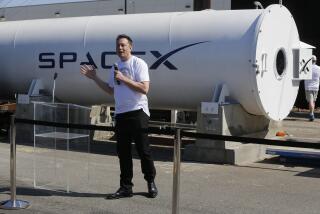Lockheed Vying to Design Replacement for Shuttle : Space: Skunk Works in Palmdale competes against McDonnell Douglas Aerospace and Rockwell International.
- Share via
PALMDALE — Call it “Space Shuttle: The Next Generation.”
The National Aeronautics and Space Administration has chosen Lockheed and two other Southland aerospace companies as finalists in the development of a less-expensive replacement for the space shuttle.
The X-33 program, as NASA calls the project, is potentially worth $650 million if a single space-launch vehicle is built, NASA officials said Friday. The program is designed to turn over detailed development of future launch systems to private industry.
The three X-33 finalists involve teams led by Lockheed Advanced Development Co.’s Skunk Works in Palmdale; McDonnell Douglas Aerospace in Huntington Beach, and Rockwell International Corp., which now manufactures the space shuttle.
Rocketdyne in Canoga Park is developing the propulsion systems for two of the three X-33 prototypes.
“What we’ve really done is contract for three different concepts,” said Frederick Bachtrel, deputy director for NASA’s space transportation division. “The exciting thing about this is that, engineering-wise, it will be a step forward. And it will get the government out of the launch-vehicle business.”
During the next 15 months, NASA will provide $24 million to help each finalist develop a detailed design that NASA hopes will serve as a prototype for a fully reusable vehicle that could be relaunched faster and more cheaply than the current orbiter, in the process stimulating more commercial payloads.
The shuttle takes 80 days to prepare for relaunch, contrasted with seven days or less for the Rockwell or Lockheed designs. The X-33 could be launched as early as 2004, with a fully reusable vehicle to follow from that design, Bachtrel said.
NASA’s announcement last week was good news for local aerospace companies.
“The Lockheed Skunk Works have been working for the past two years on the concept for the X-33,” Lockheed spokesman Jim Ragsdale said. “We are pleased that NASA is now beginning a design competition, and that the Lockheed concept will be entered.”
Key among NASA’s requirements for the X-33 is a single-stage launch vehicle, unlike the current shuttle, which uses two external engines and a main fuel tank that are all ejected during launch. All three proposals fit that bill. Also, each concept vehicle has the capacity to fly without a pilot, and each is fueled by liquid oxygen and liquid hydrogen.
But the similarities end there.
Lockheed’s single-stage-to-orbit (SSTO) concept is a 100-foot-long, wedge-shaped spacecraft that can deliver up to 40,000 pounds of payload. Aerodynamically, the SSTO resembles NASA’s experimental M2-F2.
“It looks like a slice of pie rounded at the three corners,” Ragsdale said. “It takes off vertically and lands horizontally, like the shuttle. But instead of having wings to give you aerodynamic abilities, it uses lifting body flight--like a glider.”
Lockheed officials said launch costs would be $600 per pound contrasted with the current shuttle system, which costs about $5,000 per pound.
Those high launch costs, combined with the improvements of Western European, Russian and Asian space launch systems, have caused the United States to lose its former domination of the payload-launching market. U.S. systems now launch about 30% of all space payloads, according to Lockheed.
Rockwell’s design looks more like NASA’s current orbiter than any other X-33 concept, featuring wings and a conical shape. Yet it features a single-stage engine with a lighter design than the current aluminum-based shuttle.
Bob Minor, president of Rockwell’s Space Division, said the winged body shape has already been proven on the current orbiter. “It’s aerodynamically low risk,” Minor said. “Any businessman knows that the first thing you look at is risk.”
The most radical concept for the X-33 may originate with McDonnell Douglas Aerospace of Huntington Beach, which is working with Boeing of Seattle.
Although McDonnell Douglas spokesman Keith Takahashi says the company will announce an official concept within a few months, he said it will most likely be based on the Delta Clipper Experimental (DCX) vehicle now being tested in White Sands, N.M.
The DCX is a 40-foot-tall vehicle with vertical takeoff and landing capabilities.
“It’s like those old science fiction movies where it takes off and lands on its own plumes,” Takahashi said. “We’ve flown it five times already and it looks very promising.”
If the McDonnell Douglas effort is rejected by NASA, the only guaranteed winner of the X-33 design competition will be Rocketdyne. As one of the nation’s premier propulsion system developers, Rocketdyne engineers are developing rival X-33 engine concepts for Lockheed and Rockwell, Rocketdyne’s parent company.
“From a Rocketdyne standpoint, I guess you could say it’s a win-win situation,” Minor said.
Ragsdale took it one step further, praising NASA’s commitment to involving business in the design of the orbiter.
“Whatever the outcome, the nation will benefit by having a new vehicle in the next century that will significantly lower the costs of placing payloads in orbit,” he said.
More to Read
Inside the business of entertainment
The Wide Shot brings you news, analysis and insights on everything from streaming wars to production — and what it all means for the future.
You may occasionally receive promotional content from the Los Angeles Times.










